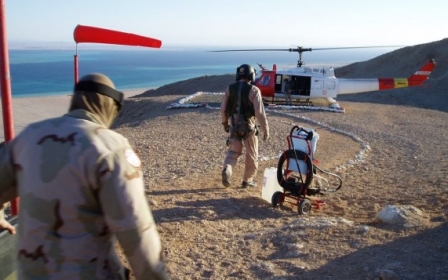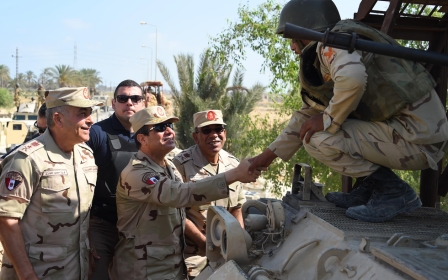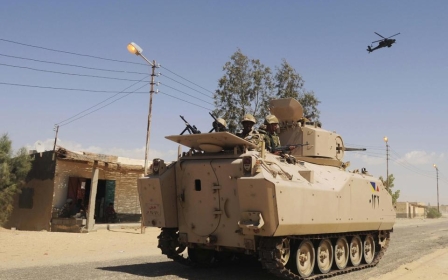Northern Sinai: Egypt’s hidden war and open wound

Last week, yet again, the international media reported that the Egyptian army had killed the head of Sinai Province (Islamic State in Sinai).
Back in Cairo, a local paper with a tad more cynicism, reported that the leader had died one too many times.
In the tragi-comedy that is the security scene in northern Sinai, this has become a daily dance: a sparring match between reality and the neo-reality that the deep state wishes to relay to Cairo, Arab capitals and Western allies. This binary is crucial to the survival of what Sisi is selling at home and abroad: his image as protector of the realm.
Problematically, the sales pitch has included both science fiction and simultaneous, systematic attempts to quell serious, professional coverage of what is truly unfolding on the ground.
In a year that saw a mammoth blow to Egyptian tourism after a Russian plane, with 224 aboard, was likely blown out of the sky by a terrorist bomb claimed by IS, Egyptian claims of “control” over northern Sinai ring hollow.
Despite the government’s best efforts to secure informational domination over what emerges about northern Sinai, particularly the hotbeds of militancy in Sheikh Zweid and Arish, alternative domestic and foreign sources of information remain, which are of paramount importance if you want to understand the northern wound that Sinai has become.
Forgotten victims
Imagine, for a moment, that you are a proud grandfather holding your nine-month-old grandson. You are smiling at one another when suddenly, rather than raindrops, a deluge of bullets zooms past and through both of you.
You feel no pain when you are shot in the chest because as you react, protectively, your nervous breakdown is immediate: you realise that one of those bullets has pierced the baby’s skull.
But you need not imagine: this is, in fact, precisely what happened, to nine-month-old Muhammad Rashad, just this week. Sickeningly, according to two Sinai press reports, the culprit was the Egyptian army.
Haphazard shooting from an army checkpoint is not a one-time accident. As I write this column another checkpoint, near Sheikh Zweid this time, injured a 10-year-old, Yasser Ibrahim Alramily.
Multiple times a day, Newsinai24 and several other local news websites, offer this counter narrative and it distills the despair of daily civilian life.
These two incidents say much about security forces who dehumanise the local population, and the poisoned well at the epicentre of the region’s dysfunctional duality.
False narrative
At its core, the situation in northern Sinai is an insurgency. Insurgencies have had, throughout history, a cri de coeur, one with a predilection towards the correction of injustice.
Once you have armed, organised guerillas who have convinced the local population that they are fighting to protect their own, the organised army has lost the "war" before it has even started.
The Egyptian government is inebriated by its own false narrative, deaf to history’s gruff lessons on guerilla warfare
Unimaginably, the army continues to help the cause of the militants; it does so in a myriad of ways. Shoot me dead, kill my children, destroy my home, displace me and mistrust me and you will have, instead of an ally, an enemy.
The Egyptian government is inebriated by its own false narrative, deaf to history’s gruff lessons on guerilla warfare and analyst warnings against losing the local population. When Sinai is in the crosshairs, Cairo easily finds its stick and, yet somehow, almost never locates its carrot.
In an environment like Sinai where tribe comes first, when you shed blood, you have lost not only the immediate family, but you have also made archenemies of the victim’s tribe. Regime losses here are multiplied because army, security and intelligence continue to have a monologue of arrogance rather than a dialogue of cooperation.
Dragon and snake
After a massive attack in late 2014 left 30 dead, a solemn, angry Sisi spoke of an “existential battle… there will be a price to pay”. That price has been paid by civilians stuck, not between a snake and mongoose, but between an earth-scorching dragon and a snake that hides among the populous and kills those who dare to provide intelligence to security forces.
After nearly three years of battling this insurgency, surely the government must be making headway? That’s the government narrative amplified by the Egyptian media, the vast majority of which is government-controlled.
But statistics and video tell a different story.
Just days ago, Sinai Province released its latest video. With it, the myth of an IS on the retreat in Sinai was blown to smithereens. The slick production shows multiple semi-trucks shuttling numerous militants as they parade with ease through northern Sinai.
Distressingly, as with previous videos, advanced weaponry abounds and masked militants operate them with the confidence of someone for whom weaponry is a mere body extension.
Contrary to the Egyptian military narrative, it is security that is seen scurrying: approximately 10 minutes into the 35-minute video, we see military personnel running for dear life while carrying a body from one armoured car to another as they come under mounted machine-gun fire and missile attacks.
Nearly halfway through, the footage turns into a horror film: after a confrontation with the army, the militants capture a tank and make away with all its armaments.
Anyone with a fifth grade education would have counted thousands of militants over these 30 months
Upon the video’s release, one close Sinai watcher wrote on social media: “I wanted to cry when I saw those terrorists atop an Egyptian tank’’.
Juxtapose this scenario with images of Egyptian soldiers being executed while others are sniped at and one begins to realise the true damage done here by the army’s insistence that Sinai is “under control”. For more than 30 months, army and police forces loudly proclaimed victories where as many as 40 terrorists were eliminated and twice as many were arrested. If these numbers were to be believed, anyone with a fifth grade education would have counted thousands of militants during that time frame.
Most estimates put the number of militants killed in Sinai Province below the 2,000 mark and, undoubtedly, the discrepancies leave the credibility of Egyptian security forces in tatters.
You can’t handle the truth
A bad habit of the Sisi clan continues to rear its ugly head: a lack of respect for a populous that it deems incapable of handling the truth. In so doing, Cairo causes an even greater disconnect as the Egyptian mainstream wakes up to the fact that the state can neither provide security, nor political pragmatism, nor economic stability.
There will be those who say what now? Where do we go from here? But deductive reasoning and rationale are not the friends of those married to an alternate reality. You cannot hope to begin to decipher the parameters of a problem if you maintain, on a monthly basis, that the problem has been solved.
This much is certain: so long as the West is willing to buy - lock, stock, and barrel, despite abundant facts to the contrary - that Sisi is able to secure Israel’s border, not much will change in Egypt’s forgotten Sinai tragedy.
On the domestic front, Egypt is an autocracy, with a meek parliament that does not embody the checks and balances laid out by a constitution that, for all practical intent, may as well not exist. Any talk of confidence building measures between the Sinai population and the security forces is useless, so long as both sides operate within self-enclosed circles of mistrust.
So long as the West is willing to buy - lock, stock, and barrel - that Sisi is able to secure Israel’s border, not much will change in Egypt’s forgotten Sinai tragedy
Essentially, the government has zero incentive to fix the problem because, while it continues to haemorrhage losses on a daily basis as a result of the insurgency, it judges those losses as acceptable because it is lower ranked soldiers who are being killed.
But even as attacks spike, the government’s strategy remains unchanged. As a recent Tahrir Institute Egypt Security Watch report points out, attacks rose nearly 100 percent from the final quarter of 2015 to the second quarter of 2016.
But explosions are a funny, nearly impossible, beast to predict. Continue to tempt the devil of instability, particularly in northern Sinai and the northern wound will become the national wound.
Within the past hour, two more Sinai locals perished in a hail of army bullets. In this country, life is cheap and words fall upon deaf ears.
- Amr Khalifa is a freelance journalist and analyst recently published in Ahram Online, Mada Masr, The New Arab, Muftah and Daily News Egypt. You can follow him on Twitter @cairo67unedited.
The views expressed in this article belong to the author and do not necessarily reflect the editorial policy of Middle East Eye.
Photo: An Egyptian man stands in an armoured vehicle as residents gather outside a police station in North Sinai's provincial capital of El-Arish after it was targeted by a car bomb in April 2015 (AFP)
New MEE newsletter: Jerusalem Dispatch
Sign up to get the latest insights and analysis on Israel-Palestine, alongside Turkey Unpacked and other MEE newsletters
Middle East Eye delivers independent and unrivalled coverage and analysis of the Middle East, North Africa and beyond. To learn more about republishing this content and the associated fees, please fill out this form. More about MEE can be found here.





